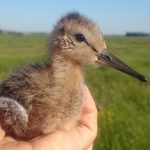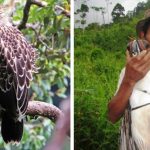← Back
Cuckoos’ migration from South Korea to the South of Africa
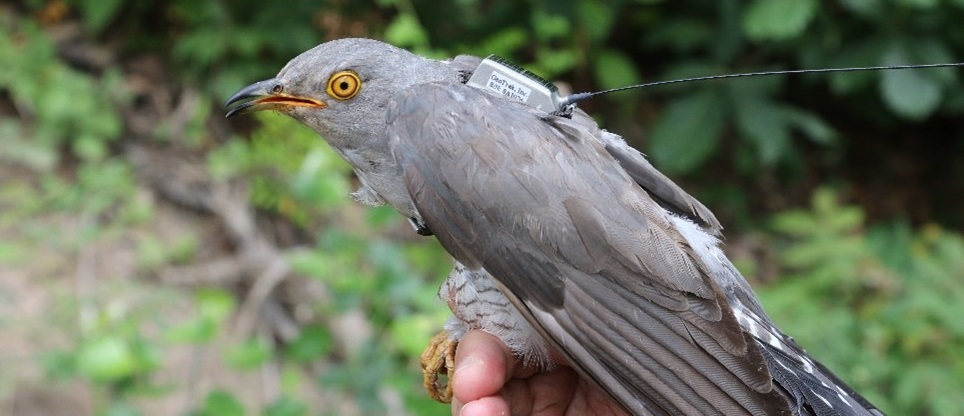
Common cuckoos are found in Eurasia, from Europe to Korea. All over the continent, they migrate to Africa, while they parasite different birds’ nests. Tracking them using Argos helps understand the similarities and differences between all of them.
Main Photo: A male cuckoo with a tag in Muan, 2019 (ID62399 (Credit Jin-Won Lee)
The common cuckoo (Cuculus canorus), like the great spotted cuckoo (Great spotted cuckoos tracked far from the nest by Argos) is migratory. It is found widely in Eurasia during its breeding periods. It migrates to winter in tropical Africa mostly, even when breeding in far-east Asian countries such as Korea. As the chicks never meet their biological parents, their migratory behaviors are fully innate.
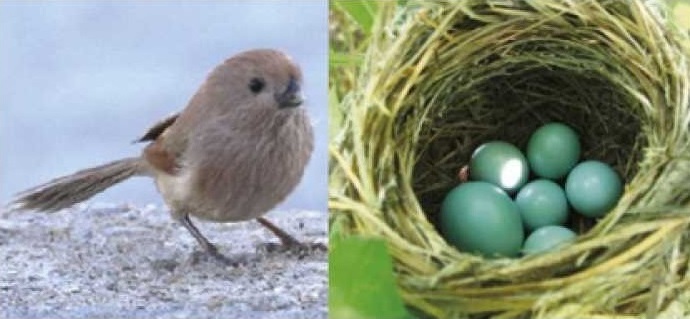 Vinous-throated parrotbill and a nest of this species. A bigger egg in the nest is a cuckoo’s (from [Lee et al., 2023]) |
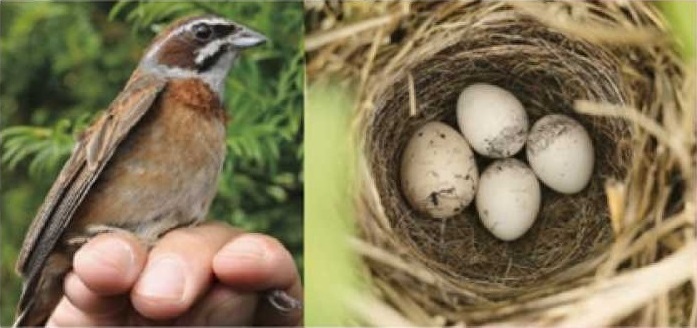 A meadow bunting and a nest of this species. A bigger egg in the nest is a cuckoo’s (from [Lee et al., 2023]) |
Even if it is considered a species, common cuckoos are genetically different depending on the host species that they parasitize (more than 200 of them have been observed). Does a gens, as a group of individuals sharing the same host species can be called, has the same migratory behavior? including migration timing, route, and duration, major stopovers and non-breeding locations. Does all gentes? Or do different gentes have different behaviors?
Tracking common cuckoos from South Korea to Africa, and back
Ten adult male common cuckoos were tagged with 5 g solar Argos PTT in South Korea during the breeding season (May-June) in 2019 and tracked until August 31, 2020, or until transmission was lost. They were chosen in three different populations in South Korea (Yangypeong, Muan and Jeju Island), representing two different gentes – In Yangypeong and Muan, the cuckoo parasitizes primarily the vinous-throated parrotbill, in Jeju Islands the meadow bunting.
Five cuckoos of each gens was tagged. Five individuals (four parrotbill gentes and one bunting gens) arrived on the non-breeding grounds in Africa with tags, and returned to Korea. They seem to show site fidelity to their breeding ground.
More info about animal tracking with Argos
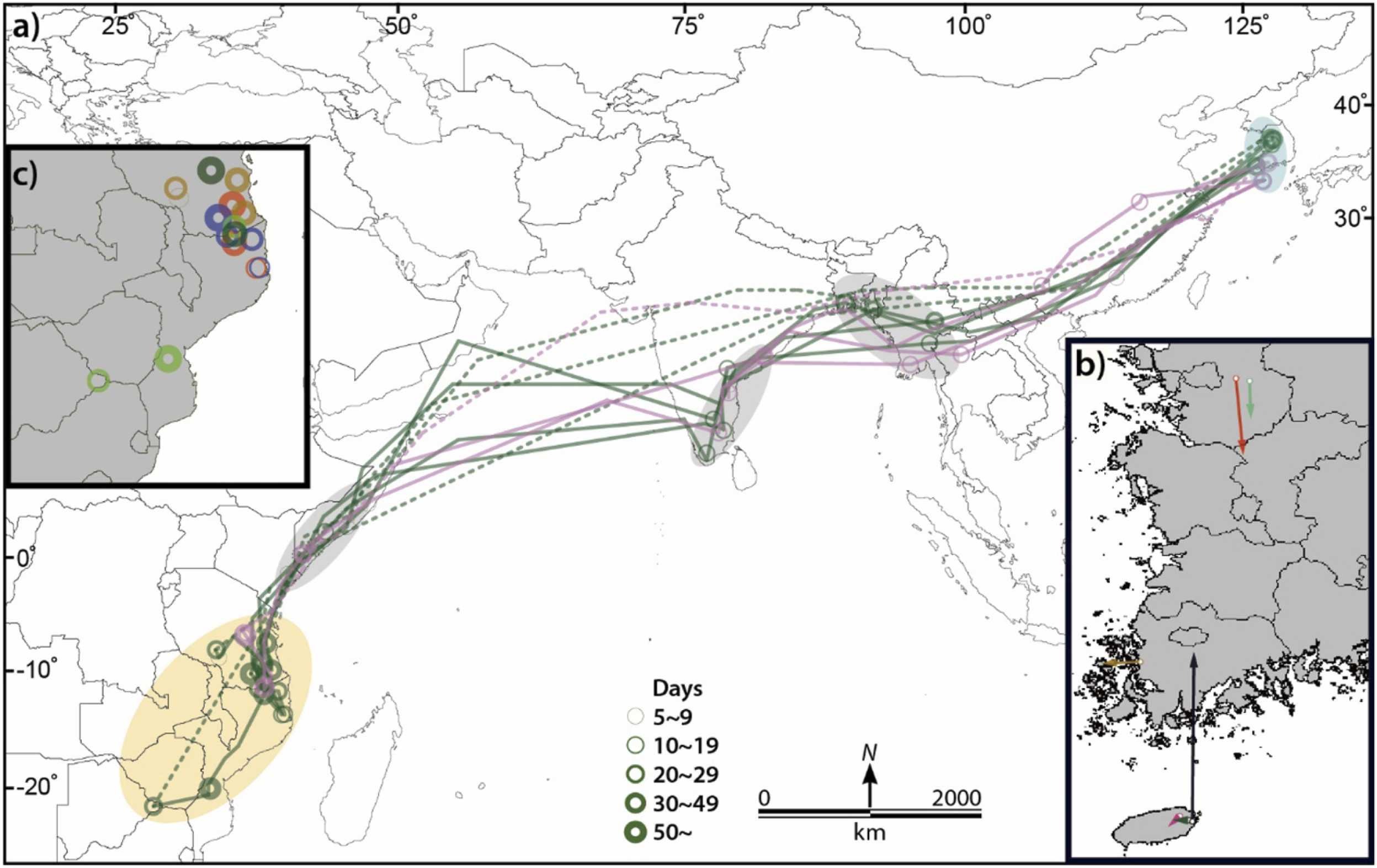
Migration of eight common cuckoos tracked from Korea in 2019 (a). Migration routes according to cuckoo gentes (green: parrotbill gens, pink: bunting gens) with major staging areas as ovals (blue: breeding area, grey: major stopover areas, yellow: non-breeding area). Each line represents different individuals, in which solid lines represent the post-breeding migration routes, and dotted lines represent the return migrations. Lines end where the PTT transmissions were lost. Each open circle represents the site where individuals stayed for more than five days and the thickness of the circle’s line vary according to its duration. (b) Pre-migration movement. The open circle where the arrow starts indicates the breeding area and the end of the arrow represents the area where they stay until leaving Korea. (c) Staging areas during the non-breeding season. Circles represent the areas where individuals stayed for more than five days during the non-breeding season. Line thickness of circles varies according to days stayed. Both b and c are color-coded by individuals (from [Lee et al., 2023])
The followed routes were similar for all recorded paths, irrespective of the gentes. The cuckoos migrated along a narrow corridor, with three stopovers on winter migrations, one in spring. Going from Korea to Africa, the birds stopped in an area across Myanmar and Bangladesh, then in South India (over 10 days in both cases) and finally in Somalia. On the trip back, they only stopped significantly in Somalia before crossing the Arabian Sea. This crossing is in fact the major difficulty in the whole migration, with about 3000 km of open water to overfly.
Moreover, the monsoon winds change with the seasons (southwesterly winds from April to September, northeasterly winds October to March — approximately), probably timing the stopovers and afterward sea crossing of the cuckoos – they left India at the end of October in winter, Somalia end of April in spring. One individual made a detour to Oman during the journey over the Arabian Sea, due to cyclone Kyarr
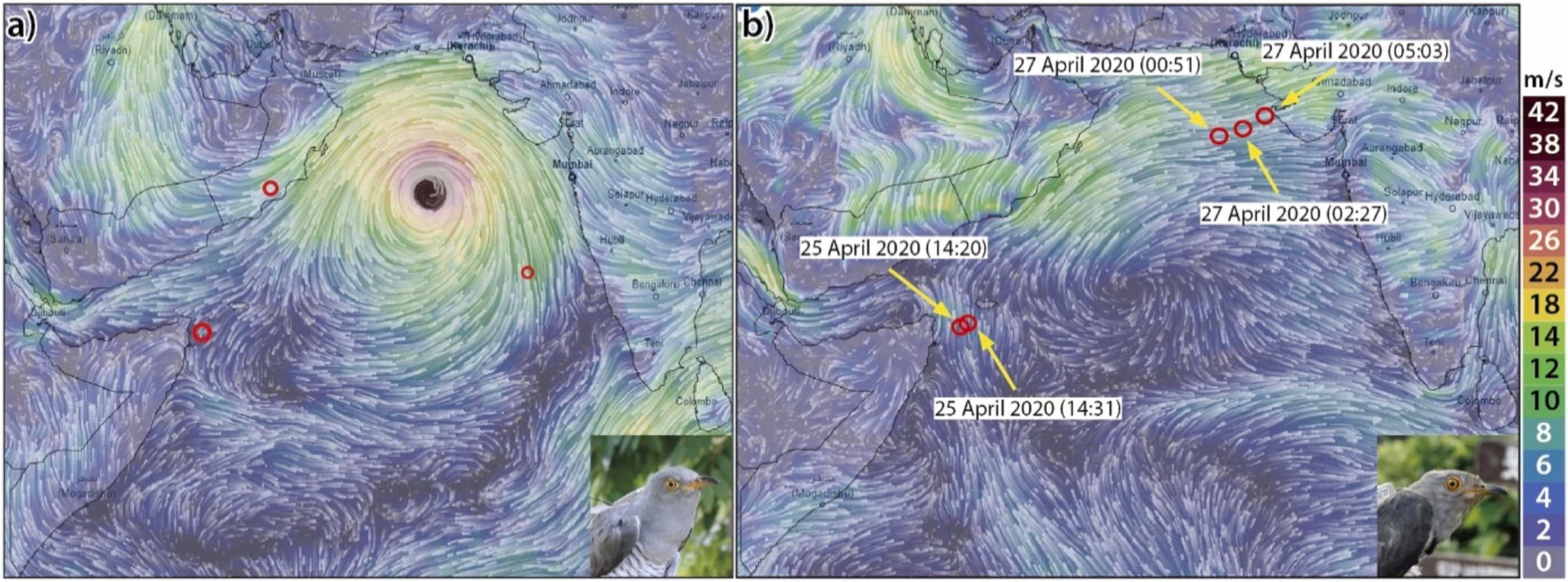
Examples of Arabian sea-crossings by migrating cuckoos. (a) Crossing the stormy sea. The route of sea-crossing by the cuckoo matched the wind direction of the cyclone Kyarr (October 29, 2019). The red circle indicates where the transmission was sent and increases in size as the bird moves. (b) Non-stop sea-crossing over two days. The cuckoo sent five consecutive transmissions over the Arabian Sea over two days. The red circle indicates where the transmission was sent with its time and date. Wind data at 12 am on April 26, 2020 is presented. The white lines indicate the wind direction at altitude of 250 m above sea level and different background colors represent different wind speeds. Wind data was visualized from Ventusky (accessed 22 August 2022). (from [Lee et al., 2023])
After a short stopover in Somalia, they moved along the coast of Somalia and Kenya to reach the non-breeding grounds located mostly in Tanzania and Mozambique. One bird (parrotbill gens) went further south, to Botswana.
Similarities and differences with the common cuckoo European populations
The Korean cuckoos’ migration patterns and even the final destination are very different from the ones recorded for European populations. The whole travel is of course completely different but also the distance (22,000 km vs 16,000 km), the timing –departures are later in the year, possibly due to a warmer climate in South Korea, the fact they come back roughly along the same path both ways (while European cuckoos make a loop), etc. There are some analogies, though, such as having a stopover after crossing a harsh environment (Arabian Sea or Sahara).
Other studies tracking Chinese and Mongolian cuckoos showed use of the same stopover areas, which should thus be considered critical for conservation of the species.
Tracking more cuckoos from the same two gentes and also others, tagging females as well as males and more generally examining environmental data in correlation with those locations will be worthwhile to better understand such long-range migrations.
Reference
- Jin-Won Lee, Seung-Gu Kang, Ji-Yeon Lee, Hae-Ni Kim, Sue-Jeong Jin, Geun-Won Bae, Wee-Haeng Hur, Jin-Young Park, 2023, Long-distance migration of Korean common cuckoos with different host specificities, Global Ecology and Conservation, Volume 43, e02426, https://doi.org/10.1016/j.gecco.2023.e02426.


